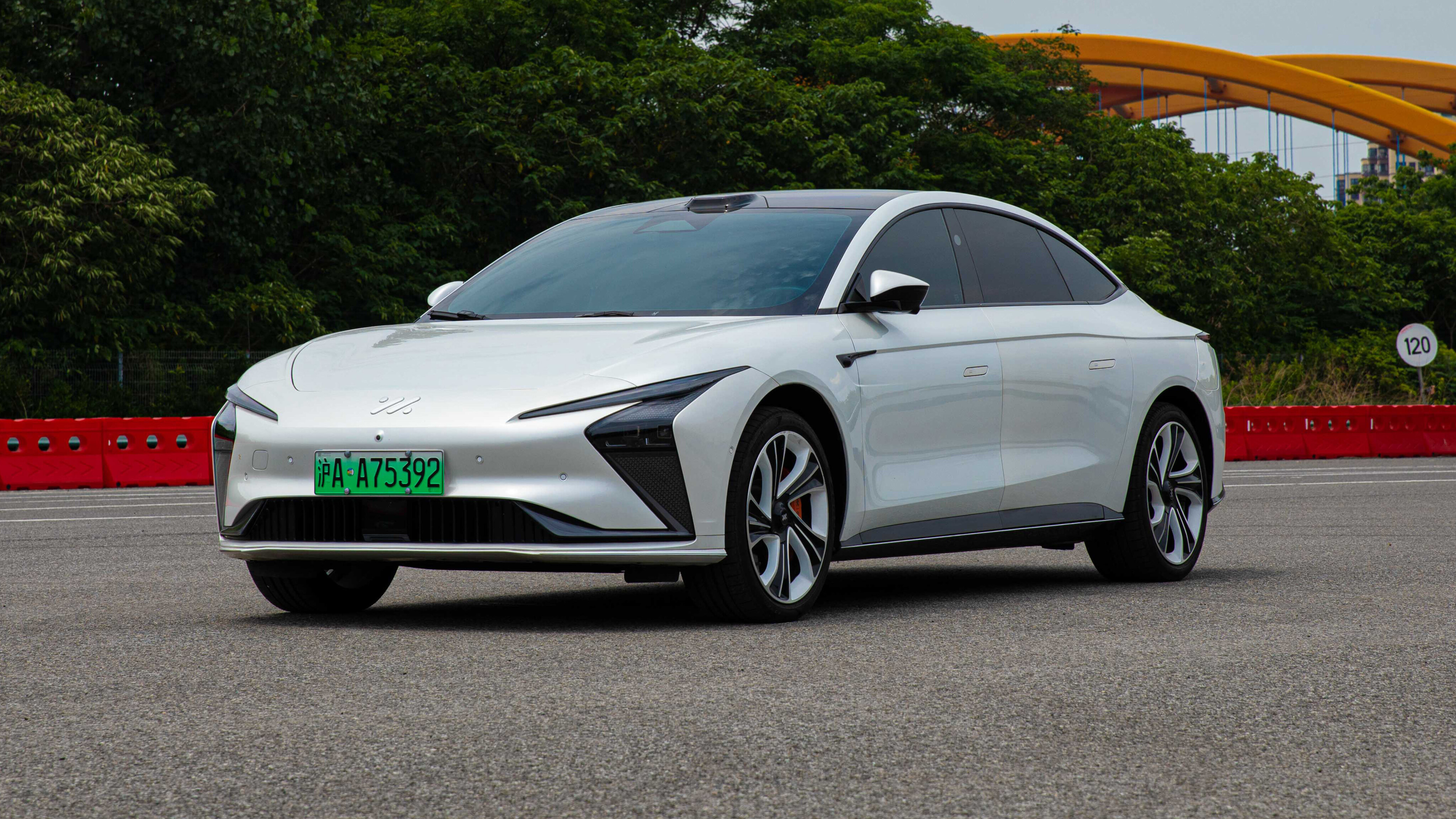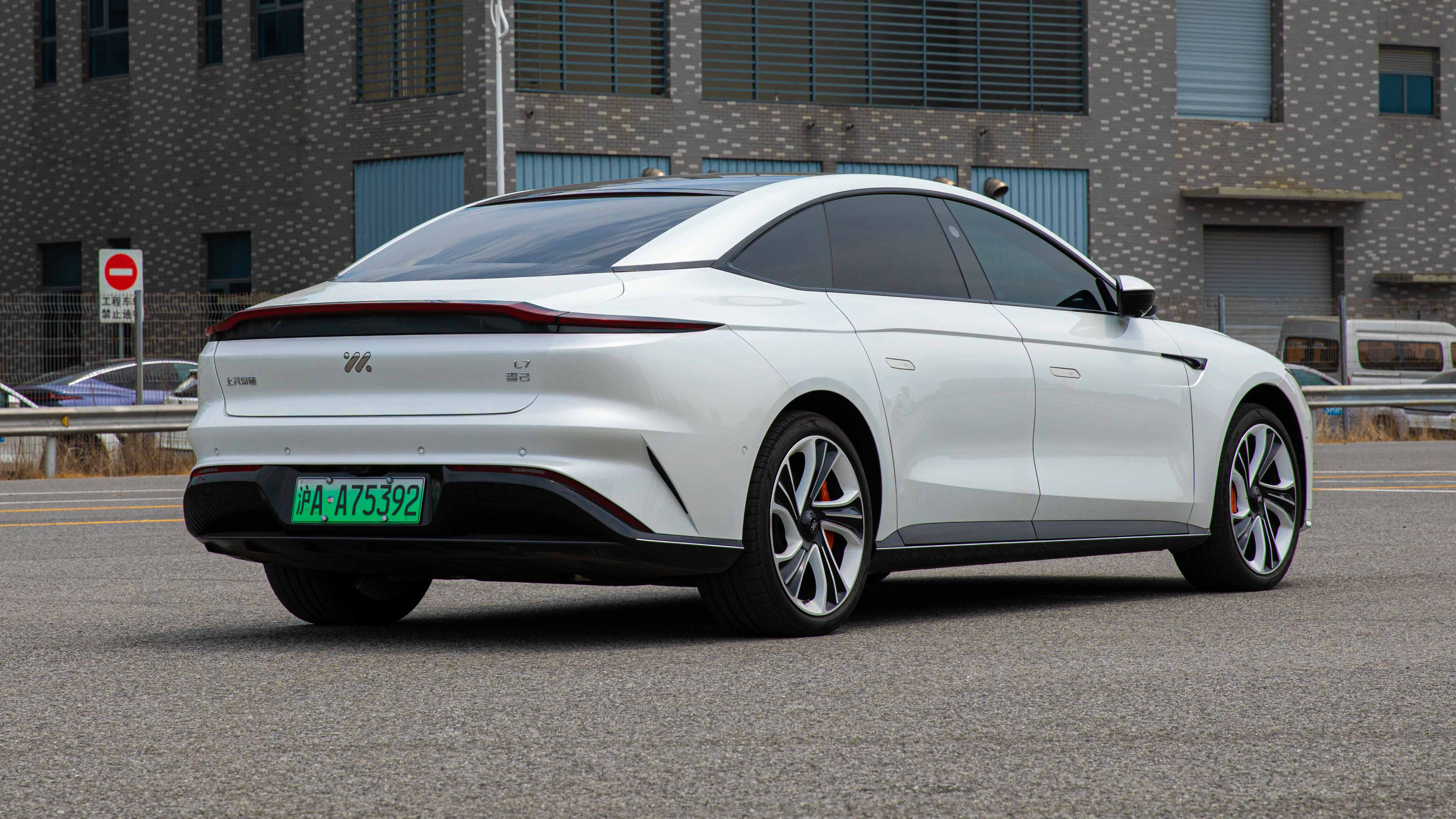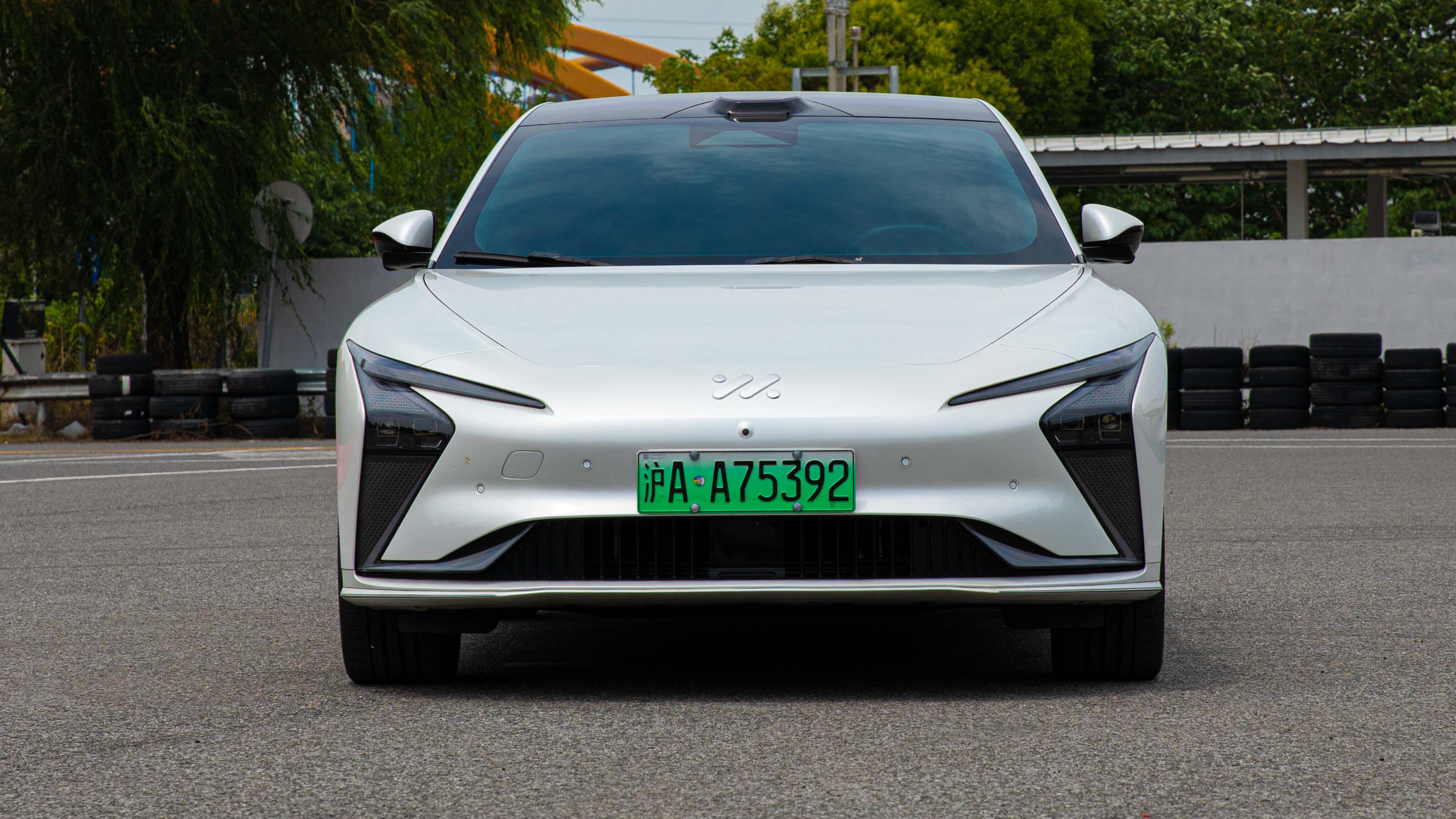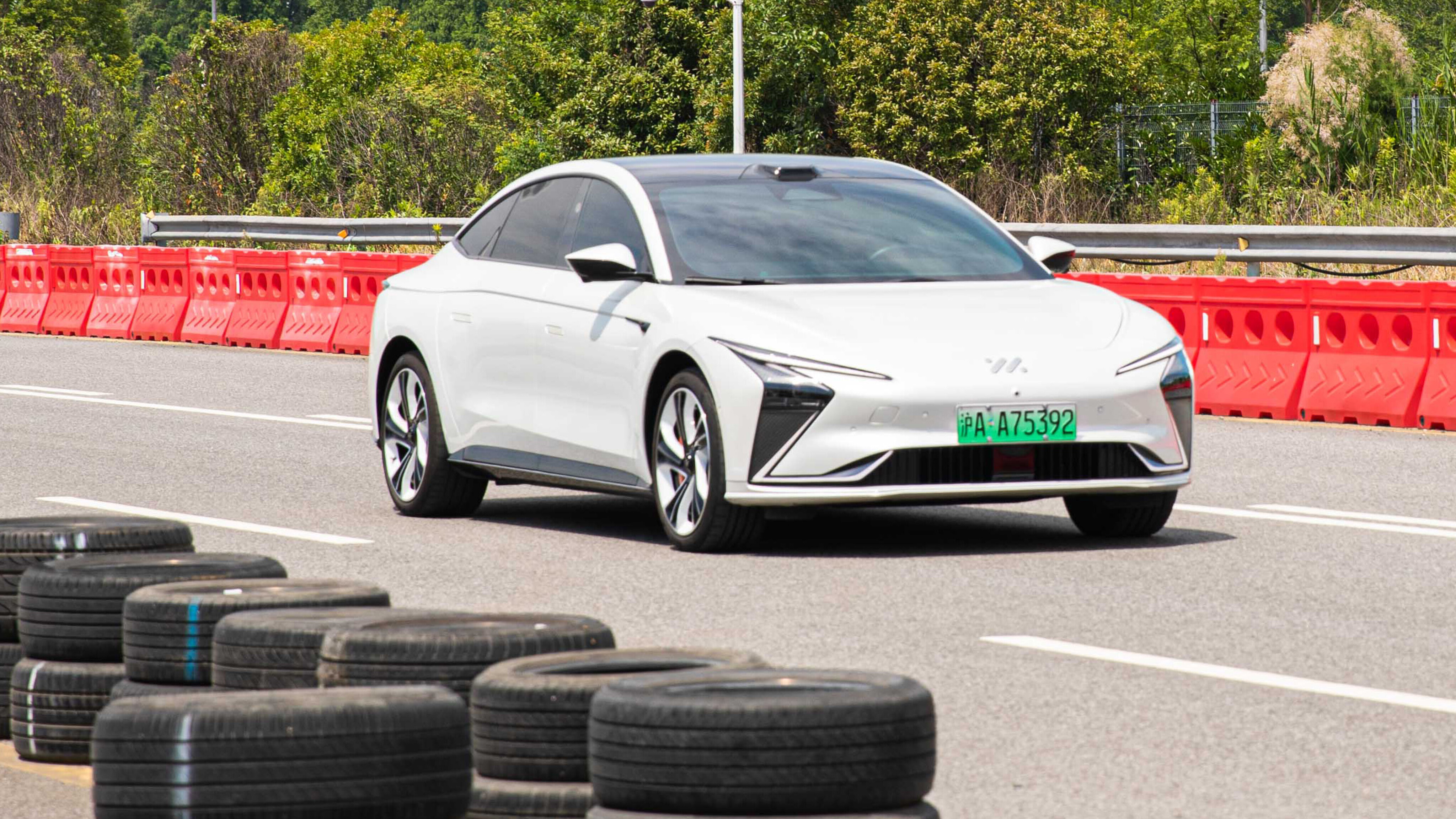
Things we like
- Punchy dual-motor acceleration
- Surprisingly luxe interior
- “WTF is that” head-turning appeal
Not so much
- Hating ourselves for liking the fake V8 noise
- Jury’s out on build quality
- Feels heavy (like all EVs)
What is the MG L7 and what are its key rivals?
The L7 is an intriguing electric, four-door large sedan made by SAIC in China and is basically a sedan version of the LS7 SUV. It’s badged as “IM Motors” but if it came to Australia, it would be an MG.
In China, the L7 is billed as a Tesla Model S rival. Five metres long and with a three-metre wheelbase, the L7 comes in dual-motor, all-wheel-drive specification or single-motor guise with rear-wheel drive. The AWD model has 425kW/725Nm while the rear-driver, 250kW. There’s also a “sports package” which raises outputs to a titillating 445kW/730Nm.
With the car not slated for Australia until at least 2025, it’s far too early to speculate which models and powertrains might make it Down Under.
In China, there are two battery options – a sizeable 97kWh (lithium-ion) offering around 615km range (CLTC); and a massive 118kWh pack with a Sydney-to-Melbourne-crushing 1000km claimed range (CLTC).

Williams Engineering helped develop the chassis, which also has all-wheel-steering.
The L7 has 12 exterior cameras and claims Level 2.5 autonomous driving capability (down the freeway or city streets) and SAIC also claims it can park itself autonomously, later able to be summoned by the driver. The jury is well out on whether any of this would be legal in Australia by the time it arrives, and we didn’t get to try any of it on our very short test.
Inside, a huge, 39-inch digital display spans the entire dash while a 12.3-inch central touchscreen contains other controls such as for HVAC and the powerful, 1120-watt, 22-speaker sound system. There are also automatic opening front doors – press a button and an electric motor opens or closes them for you.
When is the MG L7 due in Australia?
MG said the L7 is “under strong consideration” for Australia, and if it came, it would be around 2025. Australia is likely to receive either the L7 or MG F7 which we’re reviewed separately.
What's it like to drive?
Perhaps the most provocative feature of the L7 is its fake V8 engine sound. Pop it into Sport mode and the entire 39-inch screen drops halfway into the dash – improving visibility – as a low, convincing V8 burble enters the cabin at idle. You can even rev it.

Boot it and it ‘kicks down’ as a V8 roars to ‘redline’. It sounds a little bit obviously fake in the ‘upper revs’ but for a first effort, it’s pretty good. You’re guaranteed to laugh out loud, at least the first time.
Having paddle shifters makes you naturally try to change up gears, but nothing happened in the L7 we drove. MG should engineer some artificial gears to go with the fake noise, we reckon. It would be even more hilarious.
The L7 feels very luxurious inside, its black leather interior with microsuede ceiling lining giving it a sinister, rebellious ambience – which does go with the fake V8 noise. It’s quite a large car but it’s very easy to drive at low speeds with light steering, a lovely soft ride quality and the smoothness, response and serenity we’ve come to expect from electric cars.

The 425kW version we drove claims 0-100km/h in 3.9 seconds and felt plenty brisk to us on our very brief drive around a test track in Shanghai.
Push it into a corner and the L7 has plenty of lateral grip, although it quickly lapses into understeer as it tries to deal with its 2290kg kerb weight. Unlike the F7 sedan we also reviewed, there is no “rear-drive” mode, which is a pity. Drifting with the fake V8 noise would be a game-changing driving experience for an EV sedan.

Is it worth waiting for the LG L7?
It’s a bit of an ask to wait until 2025, but if you’re wanting a surprisingly comfortable all-electric sedan that’s guaranteed to turn heads in Australia with looks of “WTF is that?!” the L7 might be for you.
Build quality of the vehicles we drove seemed good, although panel gaps varied a lot and some panels didn’t quite fit perfectly together.
The rear-drive, 250kW L7 costs the equivalent of about AU$70K in China while the 425kW/725Nm model we drove cost around AU$85K. The 445kW dual-motor L7 Snake Performance starts from around AU$100K. That’s not necessarily indicative of its cost in Australia, and MG said local pricing would be confirmed closer to 2025.
More EV stories to help you choose the best car for your needs
🚘 EV news, reviews, advice & guides
- ❓ Short & sweet: Your EV questions answered
- ⚡ New EVs: Everything coming to Australia
- 🥇 Australia's EVs with the longest driving range
- ⚖️ Best-value EVs by driving range
- 💰 How much do EVs cost in Australia?
- 😰 How much more expensive are EVs?
- ⚖️ Number crunching: Is it time to switch to an EV?
- ♻ Should you buy a used EV?
- 🛡️ Are EVs more expensive to insure?
- 🆚 Costs compared: Charging an EV vs fueling a car
- 📖 EV charging guide
- 🚧 Are there enough EV chargers in Oz?
- 👨🔧 EV servicing explained
- 🔋 EV battery types explained
- 🪫 When do EV batteries need replacing?
- 🆚 Hydrogen v EVs: What's best for Oz?
- 🌏 How sustainable are EVs, really?
MORE advice stories to help you with buying and owning a car
| 2023 MG L7 specifications | |
|---|---|
| Powertrain | dual electric motors (F/R) |
| Max power | 425kW (175kW F, 250kW R) |
| Max torque | 725Nm |
| Transmission | Single-speed |
| Body | Five-seat large liftback sedan |
| L/W/H | 5098/1960/1485mm |
| Wheelbase | 3100mm |
| Boot space | 450L (estimate) |
| Weight | 2290kg |
| Battery size | 90kWh |
| Range | 615km (CLTC, claimed) |
| Suspension | Front: struts / Rear: multi-link |
| Steering | Electric rack-and-pinion |
| Brakes | Front: ventilated discs / Rear: solid discs |
| Wheels | 20-inch diameter |
| Tyres | Pirelli P-Zero |
| Tyre size & spare | 275/35R20, puncture repair kit |
Things we like
- Punchy dual-motor acceleration
- Surprisingly luxe interior
- “WTF is that” head-turning appeal
Not so much
- Hating ourselves for liking the fake V8 noise
- Jury’s out on build quality
- Feels heavy (like all EVs)



COMMENTS